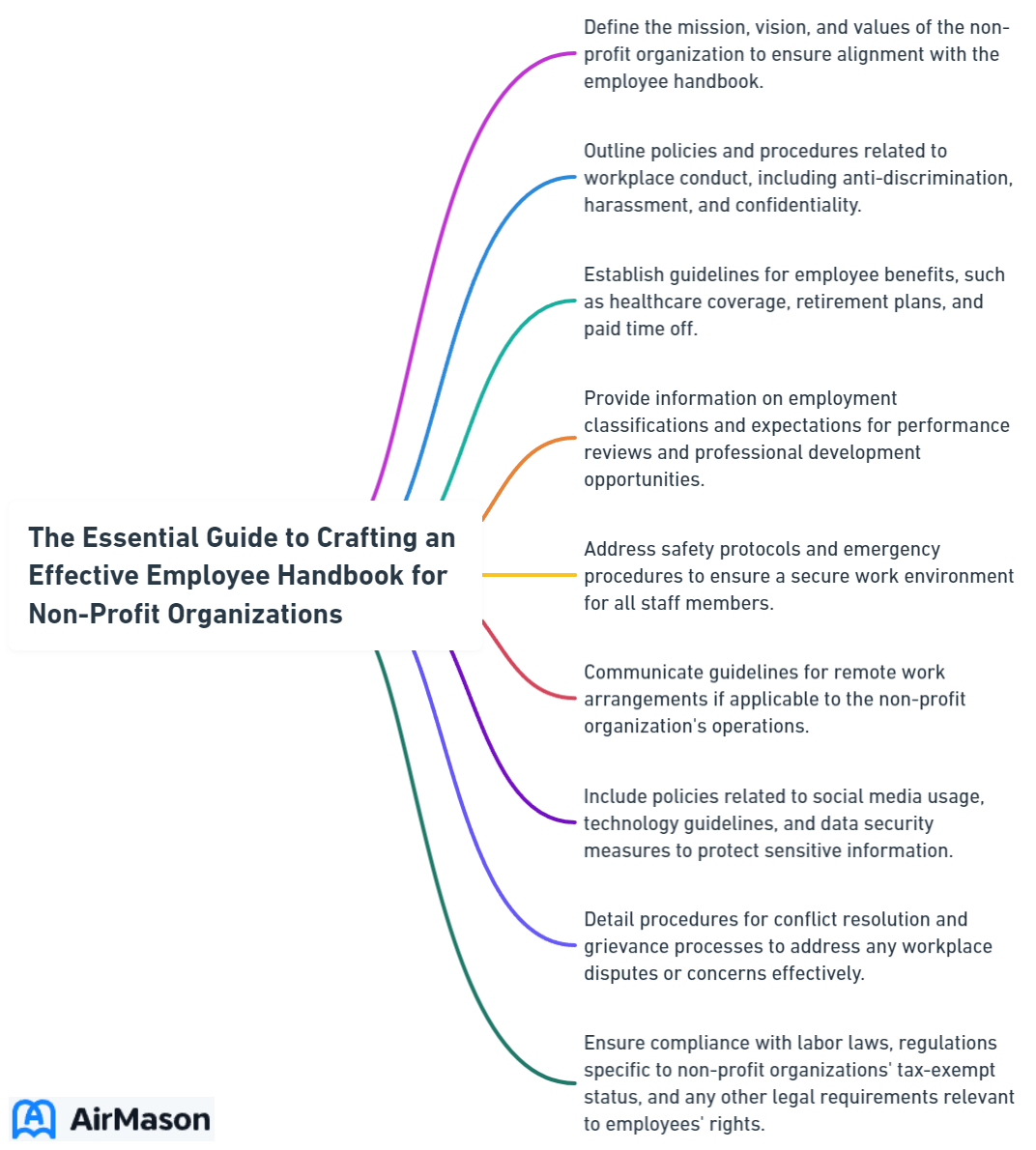
Does your non-profit need an employee handbook that reflects your values and complies with the law? Striking this balance is crucial, and our guide dives right into how you can create a structured, informative, and mission-aligned “employee handbook for non-profit” that serves as a key resource for your employees.
Key Takeaways
- A comprehensive employee handbook is a critical tool in non-profit organizations for risk management, legal compliance, fostering a shared understanding of values, and aligning employee behavior with the non-profit mission.
- An effective employee handbook must include essential components such as organizational policies and procedures, employee rights and responsibilities, and details about benefits and resources, all regularly updated to reflect legal and organizational changes.
- Customizing the employee handbook to reflect the unique culture and legal requirements of the non-profit, involving stakeholders in its development, and ensuring clear communication and training upon implementation are key to its effectiveness.
Employee Handbook Ethics
Employee handbook ethics are crucial for establishing a framework of integrity and responsibility within an organization. These guidelines serve as a compass for employees, outlining expected behavior and ethical standards in various work-related situations. By clearly articulating these principles, the handbook helps foster a culture of trust and respect among colleagues. Additionally, it ensures consistency in decision-making processes and promotes accountability at all levels of the organization. Regular updates and revisions to the handbook are essential to reflect evolving ethical considerations and legal requirements, ensuring its relevance and effectiveness over time.

The Importance of Employee Handbooks in Non-Profit Organizations
An effective employee handbook holds significant value in non-profit organizations. A well-crafted employee handbook:
- Acts as a risk management tool, setting clear expectations and outlining consequences for not meeting those expectations
- Is a beacon of transparency, presenting an overview of your organization’s policies
- Helps to inform employees about their workplace rules
Employee handbooks in nonprofit organizations serve multiple purposes, and an employee handbook serves as a tool for nonprofit employers to:
- Legal compliance and risk management
- Promoting fairness and a shared understanding of values and expectations
- Aligning employee behavior and performance standards with the non-profit’s mission
- Upholding an inclusive and diverse workplace through non-discrimination and equal employment opportunity policies
These handbooks serve as a compass for employees and help create a positive work environment.
Building a Strong Foundation: Mission, Values, and Culture

Crafting an effective employee handbook starts with building a strong foundation. It’s about articulating your non-profit’s mission, values, and culture in a way that resonates with your employees and encourages a shared commitment to your goals. This foundation sets the tone for your entire handbook and serves as a guiding light for your staff as they navigate their roles and responsibilities within your organization.
Aligning with Organizational Goals
Just as the wheels of a car must align for a smooth journey, the employee handbook should align with your organizational goals. It ensures that all parts of your organization are moving in the same direction and contributing to your overall success. This alignment begins with a clear statement of your mission and values, setting the tone for the document and providing critical context for all the following information.
Incorporating the mission and values into the employee handbook helps employees align their daily actions with your non-profit’s strategic objectives. Creating this alignment goes beyond merely documenting policies; it involves fostering a culture where employees, including the executive director, comprehend their roles, adhere to the organization’s ethical standards, and contribute towards achieving strategic goals.
Open communication about the importance of policy alignment with the organization’s goals cultivates a positive work culture and is instrumental in reaching those goals.
Promoting a Positive Work Environment
A positive work environment is the bedrock of an engaged and productive workforce. Your employee handbook plays a significant role in shaping this environment. By outlining clear organization’s policies and procedures, your handbook demonstrates your non-profit’s commitment to fairness and equal treatment for all employees.
Moreover, setting clear expectations is paramount. When your handbook outlines the expectations for employee behavior, performance, and compliance with policies, it helps to foster a healthy employment relationship through effective communication and positive reinforcement. Moreover, including details on benefits and resources demonstrates your non-profit’s commitment to employee well-being and growth, further contributing to a positive and supportive work environment.
Essential Components of a Non-Profit Employee Handbook

An effective employee handbook resembles a well-assembled puzzle, with each piece playing a vital role in completing the bigger picture. The key components of this puzzle include:
- Mission and values
- Policies and procedures
- Employee rights and responsibilities
- Benefits and resources
These components not only ensure that your handbook is comprehensive but also make it a useful resource for your employees and a powerful tool for your organization.
Colorado Employment Law Handbook
The Colorado Employment Law Handbook serves as a comprehensive guide for employers and employees alike, offering invaluable insights into the state’s labor laws and regulations. Covering a wide range of topics including wage and hour laws, discrimination and harassment policies, and employee benefits, this handbook serves as an essential resource for navigating the complexities of employment law in Colorado. Whether you’re an employer looking to ensure compliance with state regulations or an employee seeking to understand your rights in the workplace, the Colorado Employment Law Handbook provides clear and concise information to help you navigate the ever-changing landscape of labor relations in the state.
Policies and Procedures
Policies and procedures are the nuts and bolts of your employee handbook, serving as the foundation for your organization’s policies. They help maintain a positive work environment by providing clear guidelines on conduct, attendance, time off requests, and the application of disciplinary procedures. They also ensure legal compliance by clearly stating requirements such as overtime pay for non-exempt employees, workers compensation policy, confidentiality commitments, and communication policies aligned with state and federal laws.
However, forming policies is only half the task; updating them regularly is equally important. Regular updates to the employee handbook are essential to align with legal changes and organizational shifts, ensuring consistency and providing employees with a current reference. A periodic review of the handbook is also important for updating information, checking for errors, and ensuring the exclusion of outdated practices.
Employee Rights and Responsibilities
The rights and responsibilities of employees are another crucial component of your employee handbook. By clearly stating these rights and responsibilities, your handbook helps establish a transparent and accountable work environment that fosters organizational success and growth. This clarity also serves to equip your employees with the knowledge they need about the organization’s policies, thereby protecting your organization from baseless claims.
From a legal perspective, essential policies regarding nondiscrimination and sexual harassment should be outlined in the handbook, ensuring compliance with laws and providing procedures for handling complaints. While emphasizing the non-profit’s culture, it is also important to include a disclaimer about employment-at-will status to manage expectations and reduce the risk of implied contracts.
Benefits and Resources
Benefits and resources are the perks that can attract and retain high-quality talent in your non-profit. When you include these details in your employee handbook, it demonstrates your organization’s commitment to employee welfare. Your employees should clearly understand the criteria for eligibility and participation in benefits such as vacation time, retirement plans, various types of insurance, and withholding taxes.
However, the focus shouldn’t be solely on tangible benefits. Your employee handbook should also outline employee assistance programs, including counseling services, financial planning, or legal advice that support employee well-being and help maintain work-life balance. Information regarding expense reimbursement, including the circumstances for reimbursement, documentation required, and guidelines for business travel should also be provided in your handbook.
Customizing and Adapting Your Employee Handbook

Just as no two non-profits are the same, no two employee handbooks should be the same. To reflect the unique context and culture of your organization, customizing and adapting your employee handbook is a necessary step. It’s about making the handbook truly yours, from the language and tone to the policies, procedures, and benefits you offer.
Collaborating with Stakeholders
The creation of an employee handbook isn’t a solo endeavor but a collaborative effort. Involving a diverse group of stakeholders, such as a personnel committee and local employment law experts, is crucial for creating a handbook that meets the unique needs of your organization. Including staff members on this committee ensures your handbook tackles real management issues and is understandable to all.
Ongoing engagement with your stakeholders is equally important. Their input in the development and review process of the employee handbook promotes a unified approach and keeps the content current and precise. And by including HR professionals from local corporations on the personnel committee, the policy creation process gains valuable legal and practical insights.
Ensuring Legal Compliance
Ensuring legal compliance acts as a safety net for your non-profit. Consulting with legal counsel and knowledgeable HR personnel is essential for ensuring that your employee handbook meets all legal requirements. Your handbook needs to comply with federal laws, such as the Family and Medical Leave Act (FMLA), Fair Labor Standards Act (FLSA), and Title VII of the Civil Rights Act. This will help ensure legal compliance across the country. In case of doubts, it’s important to seek legal assistance.
However, compliance isn’t only about federal laws; the handbook must also address state-specific regulations, which vary based on the state of operation, to comply with all local employment laws. Including essential legal requirements and a prominent disclaimer stating that the handbook is not an employment contract can prevent misunderstandings of at-will employment and ensure adherence to federal employment laws.
Infusing Organizational Culture
Your non-profit’s culture is its unique fingerprint, and this should be reflected in your employee handbook. Using language and anecdotes unique to your non-profit’s culture, history, and values can effectively reflect your organization’s identity in the handbook. The tone and style of your handbook should also align with your organization’s values and mission, fostering a positive work atmosphere and encouraging employee engagement.
Creating a handbook extends beyond mere policy writing; it involves embedding your unique culture into the very heart of your handbook. By infusing your culture and values into your handbook, you not only create a document that resonates with your staff but also ensure that their actions align with your organization’s objectives. Remember, your handbook should resonate with your unique organizational identity, so thoroughly tailor policies to your specific context and legal environment.
Regularly Reviewing and Updating Your Employee Handbook

Similar to any effective tool, your employee handbook, also known as an employee manual, requires regular maintenance. Regular reviews and updates are critical to maintain compliance with changing laws and to ensure your handbook reflects the evolving needs and culture of your organization. This practice should ideally be conducted annually, though some organizations may benefit from reviewing it every one to two years.
Beyond legal compliance, updating your handbook also guarantees transparent communication of any changes in company policies, procedures, and philosophy, thereby fostering an accountable and positive work environment. So, keep your handbook alive and kicking with regular reviews and updates!
Implementing and Communicating Your Employee Handbook
Upon completion of your employee handbook, it’s time to unveil it! Implementing and communicating your handbook effectively involves distributing updated versions, collecting signed acknowledgments, and providing training and support for employees and managers.
Distribute the new version of the manual to every employee, using a method that provides proof of delivery. This could include making it available electronically, providing hard copies, and collecting signed acknowledgments during new-hire orientation or handbook rollout.
Employee acknowledgment is crucial, requiring them to sign a form to confirm they have read and agree to the policies and procedures outlined in the handbook. Following a revision, nonprofits commonly ask employees to sign an acknowledgment form indicating receipt, comprehension, and understanding of new policies.
Training managers on new policies before rolling out changes helps ensure accurate and consistent interpretation and enforcement across the organization. To enhance understanding of the handbook, consider utilizing:
- Workshops
- Seminars
- E-learning
- Mentors
- Incorporating stories, testimonials, and discussions
Summary
You’ve journeyed with us through the art of crafting an effective employee handbook for your non-profit organization. We’ve explored the importance of handbooks, the necessity of a strong foundation built on mission, values, and culture, the essential components to include, and the need for customization and adaptation. We’ve highlighted the importance of regular reviews and updates and discussed strategies for implementation and communication. So, embrace the potential of your employee handbook, let it reflect your non-profit’s unique identity, mission, and values, and watch it become a strategic tool that drives performance, manages risk, and shapes your organization’s culture.
Frequently Asked Questions
What should be in a nonprofit handbook?
You should include employee handbooks in a nonprofit handbook to outline policies and expectations for staff. This helps ensure clear communication and adherence to organizational standards.
What HR policies should a nonprofit have?
A nonprofit organization should have critical HR policies in place to ensure effective governance and management of human resources. These policies may include codes of conduct, anti-discrimination and harassment, performance management, and leave and time off policies.
What is legally required to be in an employee handbook?
An employee handbook should legally include topics such as minimum wage and overtime regulations, anti-discrimination and harassment policies, family and medical leave policies, safety and health regulations, time off and paid leave policies, social media and technology usage policies, privacy and confidentiality policies, the employer’s mission statement, equal employment opportunity statement, contractual disclaimer, and at-will employment statement (where allowed).
Why is an employee handbook important for a non-profit organization?
An employee handbook is important for a non-profit organization because it ensures legal compliance, acts as a risk management tool, promotes fairness, and fosters a shared understanding of the organization’s values and expectations. Having a clear and comprehensive handbook can benefit both the organization and its employees.
How can I align my employee handbook with my non-profit’s goals?
To align your employee handbook with your non-profit’s goals, start by clearly stating your mission and values, involve employees in policy development, and maintain open communication about the importance of alignment with organizational goals.
Important Disclaimer:
Please be aware that the content on this page has been generated by using artificial intelligence language models and may contain errors, inconsistencies, or outdated information. It is provided as-is without any warranties or guarantees of accuracy.
We strongly recommend using this content as a starting point for further research. We disclaim any liability for damages or losses resulting from the use or reliance on this content.